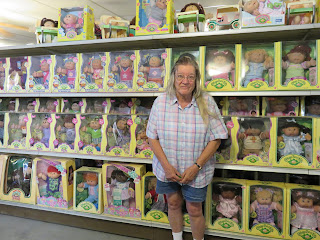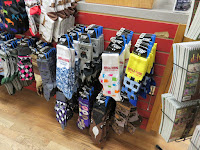The Blue Charley Chronicles has moved! Please visit the new site at The Blue Charley Chronicles – Roadside attractions, small towns, museums, and more from the USA
Tucked away in a warehouse in the farming town of Griswold,
Iowa, is one extraordinary collection of Cabbage Patch Kids. In 1985, Donna
Brown and her family were victims of a house fire. At the time the Cabbage
Patch Kids were capturing America’s fancy far and wide.
“I was collecting dolls and I just collected any doll,”
Donna says. “And then my daughter wanted to start the collection again, and I told
her, ‘I don’t really want to collect all the other dolls again. So let’s just
pick one kind.’ And so she got that little one in the striped suit there, so we
decided to collect Cabbage Patch.”
Donna built up her collection through flea markets, thrift
stores, garage sales, and gifts from family and friends. Her husband would stay
up nights searching the Internet and “always managed to get them.” In 2008,
they built the warehouse. Unfortunately, her husband passed away only a couple
of years later. But Fantasyland was already set up for success.
“I joined a newsletter, and my granddaughter puts it on Facebook
and stuff, and then we got the signs on the highway, and the word of mouth
really,” Donna remarks. “When we first started this, we went around to all the
little towns with flyers.
“When we first started, we had them in the house. Then we
wanted to get them out of the house, so we got a trailer house and filled that
up. Then we got another trailer house, and then we decided to make this museum.
When we was building this I told my husband, ‘This is not going to be big
enough,’ and he said ‘This is going to be big enough.’ It wasn’t.”
The donations have come fast and furious.
“We got another car load yesterday,” she says. “Of course
I’m known as the Cabbage Patch lady, and anybody that don’t want their Cabbage
Patches, they bring them to me.
Cabbage Patch Kids were invented by Xavier Roberts, an art
student from Georgia, in 1978. He created soft sculptures using the German technique
for fabric sculpture and developed an idea for adoptable dolls he’d call “Little
People.” They were made for family and friends and exhibited at art shows. He
began selling them and in 1982 he entered into a licensing agreement which
allowed for a toy replica of the Little People Originals. Those replicas, which
are of smaller size and have vinyl heads, became the Cabbage Patch Kids.
If it’s something to do with Cabbage Patch, Donna probably
has it: furniture, toys, accessories, buttons, magazines, lunch boxes, and much
more. And she has possibly every edition made, from the rarest to the most
common.
She takes me through case by case, display by display. There’s
ones made for the March of Dimes (an edition which netted over $130,000 for the
organization). Another was made special for Germany. There are Cabbage Patch
Dolls with matching animals, ones made larger just for Toys R Us in New York
(called “Tru Kids”), and dogs and cats with the Cabbage Patch face. In the Philippines,
a company made its own version called “Taro Patch.”
Perhaps most interestingly is the case of the Snack Time
Kids. They came out in 1996 and didn’t last long. Designed to eat accompanying
plastic food, some of these dolls got mouthfuls of human hair and fingers.
Donna shows me how they work, but now she’s hesitant to demonstrate them to
kids.
“The other day a little boy came in here and put a finger
right in its mouth and said ‘I want to know if it will bite me.’ It shocked
him. I said ‘You know little kids like you is why they we don’t have them.’
Scared me to death.”
A Cabbage Patch Kid took a ride in a space shuttle; that
doll is in a museum, but Donna has created a loving tribute with descriptions
and props. Another display celebrates Cabbage Patch Kids being the mascot of
the 1992 and 1996 Olympics. There’s a school, too, complete with Cabbage Patch
coloring books and a themed bus.
Certain Cabbage Patch Kids developed dots on their skin, known
to collectors as “Pox,” and Donna made a nursery for them which includes
incubators. She used to think it the dots were mold, but learned it was an aberration
possibly due to manufacturing error or storage environments.
She has the washing machine that really works, potty chairs
which sound like a real toilet flush, and high chairs that hook onto tables so
the dolls can dine with their owners.
“I say I’d like to have one of everything they made, but I
don’t know what all they made,” she says. “Anytime it says Cabbage Patch I get
it. So we have a lot of duplicates.”
The dolls are in a variety of conditions, depending on where
or from whom she obtained them.
“If I got ‘em in the box I never did take them out of the
box,” she says. “Xavier…told everybody that had him in boxes to take them out
of the boxes because a baby wasn’t born in a box. I’ll never sell them, but
later on you don’t know what somebody else is gonna do with them…you always get
more if you have them in the box.”
Nowadays, Donna’s regular companions are the Cabbage Patch
Kids and her dog. “I was so lonely, and I got him,” she says about her
four-legged friend. “He’s grown so attached to me. I’m the only one he knows. The
vet said I’ve never seen a dog so close to anybody. He can be a pain…but at
least someone’s there moving around, you know?”
A guest book proves how Fantasyland has touched the hearts
and sparked the imaginations of people far and wide. There’s not much else to
see in Griswold, after all. She’s expecting a tour bus filled with 40 people
soon, and we’re sure they’re not there to see the corn.
Additional Sources:
https://www.babylandgeneral.com/about/our-history/
https://www.roadsideamerica.com/story/48734

































































